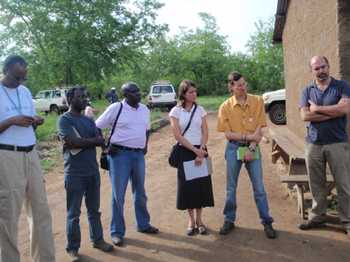Global Disease Detection Operations Center: Outbreak Response
2014: International Outbreaks
 The GDD Operations Center monitors about 30–40 public health threats each day. In 2014, the GDD Operations Center monitored and reported on over 140 unique outbreaks of different diseases occurring in more than 90 different countries. Examples of disease events that the GDD Operations Center watched closely in 2014 were:
The GDD Operations Center monitors about 30–40 public health threats each day. In 2014, the GDD Operations Center monitored and reported on over 140 unique outbreaks of different diseases occurring in more than 90 different countries. Examples of disease events that the GDD Operations Center watched closely in 2014 were:
- Ebola virus disease in West Africa
- Avian influenza (A) H5N1 in multiple countries
- Avian influenza (A) H7N9 in China
- Middle East Respiratory Syndrome-Coronavirus in multiple countries
- Wild-type polio
- Chikungunya fever in the Americas and Southern Pacific Ocean
- Measles worldwide
Nodding Syndrome
The GDD Operations Center is continuing to support investigations (begun in 2009) of a mystery illness referred to as Nodding Syndrome. Nodding Syndrome is a novel form of epileptic illness primarily affecting children aged 5-15 years, occurring in South Sudan, northern Uganda and southern Tanzania1. In 2013, CDC partnered with the Uganda Ministry of Health to conduct a large survey to determine burden and geographic distribution of the illness. For reasons that remain unclear, beginning in late 2013, new cases of Nodding Syndrome mysteriously decreased dramatically. However, investigations continue with Uganda’s Ministry of Health, including studying the brains of those affected, to better understand the pathophysiology of this previously unrecognized disease, and exploring the reasons for the dramatic decrease in new cases in Uganda. The GDD Operations Center is providing crucial operational, logistical and technical support in consultation with other experts at CDC.
Ebola in West Africa
In March 2014, the GDD Operations Center reported on deaths in Guinea associated with fever, diarrhea, vomiting, and bleeding. Laboratory testing on specimens at Institut Pasteur in Lyon, France indicated that this was an outbreak attributable to a Filovirus; subsequent testing determined that the Filovirus was Ebola virus2. The subsequent spread throughout Guinea, and then to Liberia and Sierra Leone, has resulted in the largest Ebola virus disease outbreak to date. The GDD Operations Center contributed to the early deployments of CDC staff, and is a part of the International Task Force, with Analysts serving as Desk Officers for Guinea, Liberia, and Sierra Leone.
Chikungunya and Zika viruses
Chikungunya: In December 2013, the GDD Operations Center began to see reports from the Caribbean of high fever, joint pain, rash, headache, and muscle pain. The first case of indigenous transmission of chikungunya virus, spread by mosquitos, was confirmed in December 2013 from the island of St. Martin3. Since then, transmission has become widespread. By August 2015, PAHO reported almost 1.6 million suspected cases of chikungunya, with over 250 deaths throughout the Caribbean and Central and South America4, 5.
Zika virus: Spread by mosquitos, and in the same viral family as dengue viruses, outbreaks of Zika have occurred in Africa, Southeast Asia, and the Pacific Islands since 20076. Of note is the recent occurrence of Zika in Brazil.
Because the Aedes species mosquitoes that spread chikungunya and Zika viruses are found throughout the tropical world (and some areas of the subtropics), it is likely that outbreaks will spread to new countries, including the United States. To date in 2015, no cases of Zika virus disease have been identified in the United States, and although periodic cases of chikungunya disease have been identified in travelers returning to the United States, widespread, local transmission has not yet been established.
References
- CDC. Nodding Syndrome. Page accessed 8/18/15
- CDC. Ebola (Ebola Virus Disease) Previous Updates: 2014 West Africa Outbreak. Accessed 8/18/15
- CDC. Chikungunya virus in the United States. Page accessed 8/18/15
- WHO. Chikungunya. Page accessed 8/18/15
- CDC. Chikungunya [338 KB, 1 Page]: Information for vector control programs. Page accessed 8/18/15
- CDC. Zika Virus. Page accessed 8/18/15
- Page last reviewed: September 5, 2015
- Page last updated: September 5, 2015
- Content source:


 ShareCompartir
ShareCompartir